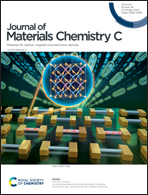Equivalent circuit modeling on defect-dipole enhanced dielectric permittivity†
Abstract
Enhanced permittivity (EP) is always sought for dielectric-related applications, and its origin is thus extremely significant but has been long debated. The most extensively accepted mechanism of EP refers to the interfacial polarization effect which is usually recognized through equivalent circuit (EC) modeling. Nevertheless, the resulting circuit parameters are sometimes unreasonable and, moreover, the EC models representing the bulk/grain response of defect-dipole enhanced permittivity are still lacking. To this end, a new EC model describing the bulk/grain polarization associated with defect-dipole relaxation is proposed in this work and is verified in (Li,In)-doped MgO and (In + Ta)-doped TiO2. EP is achieved in (Li,In)-doped MgO and clearly does not satisfy the interfacial polarization effect described by the classical brick EC model. Instead, the proposed EC model, which captures the features of UDR (universal dielectric response) power-law dependence and non-Debye response, not only separates the contributions from the defect-dipoles and matrix to the total dielectric response, but also reveals the respective dynamics. The EC model is further validated in the classical EP material (In + Ta)-doped TiO2. The established EC model is thus helpful to understand a broad class of dielectric systems with defect-dipole relaxation and to design new materials with EP.



 Please wait while we load your content...
Please wait while we load your content...